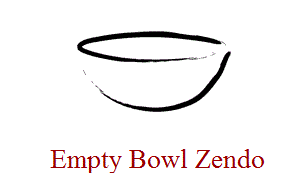Daisan A one on one private interview about one’s practice with a teacher.
Dharma –realities, the teachings, living truth, universal law.
Dharma Holder – a term first used by Maezumi Roshi for a student of Buddhism who is preparing to become a teacher
Gassho –hand position with the fingers and palms together in prayer-like position, hands about six inches from your face, finger-tips just below nose level; a gesture of respect, humility, gratitude, or all three.
Jikido –zendo timekeeper.
Jikijitsu –traditionally, the monk in charge of the zendo, second only to the teacher; the monitor who maintains order.
Jukai – ceremony of receiving (ju) the Buddhist Precepts (kai) Jukai is taking refuge in the teachings of the precepts, composed of the three refuges, the three pure precepts and the ten grave ones.
Kensho - An enlightenment or awakening experience. It is folly to try to describe this experience in words, however, a kensho reportedly gives one a glimpse of one's own nature and the true nature of reality.
Kinhin –walking meditation.
Koan - A brief anecdote recording an exchange between master and disciple or a master's enlightenment experience. Koans are used to bring a student to realization or to help clarify his enlightenment.
Kyosaku - Wake-up stick or encouragement stick. Used during long periods of zazen (mainly during sesshin) to strike practitioners on the back or on the part of the shoulders close to the neck. The kyosaku is not used for punishment: this is made clear by the fact that receiving the kyosaku is voluntary; it is never given to those who do not request it. Some request it simply to shake off sleepiness, but others say the blows can actually relax tense muscles. Ceremonial walking of the kyosaku (without any striking) is done early in the morning to signify opening the dojo and late in the evening to begin the closing.
Mindfulness - Awareness; remembering that all things are interrelated; living in the present moment. It would be difficult to overemphasize the importance of mindfulness in Zen and Buddhism. The master Muso Kokushi said: "When you walk, watch the walking, when you sit, watch the sitting, when you recline, watch the reclining, when you see and hear, watch the seeing and hearing, when you notice and cognize, watch the noticing and cognizing, when joyful, watch the joy, when angry, watch the anger."
Mudra –hand position. During zazen, hands are placed in the “Cosmic Mudra” with the left hand and fingers placed in the upturned right hand, thumbs gently touching to form a circle over the hara (just below the navel).
108 Gates Practice - a practice we offer at Empty Bowl Zendo in which we vow to sit zazen 60 minutes a day for 108 consecutive days. It is a way to deepen practice and learn more about who and what we really are, regardless of whether you are a experienced or new practitioner of Zen. In our tradition, 108 relates to the innumerable or measureless. In Gates Practice we have endless opportunities to see what the gates in our life are and learn how to encounter them. This practice includes an initial meeting with Sensei Ray and periodic one to one exchanges on the work.
Preceptor – teacher authorized to offer the precepts .
Precepts - The precepts are considered the moral and ethical teachings of Zen and are essentially about living the teachings through the development of character.
Roshi –master teacher, venerable teacher.
Samadhi –single pointed concentration.
Sangha –community of practitioners.
Samu - Selfless service; work that contributes to the maintenance of the temple and/or sangha. Periods of samu are often incorporated into practice days and may include cleaning, cooking, gardening, grounds keeping, etc.
Sensei –teacher.
Sesshin –two or more days of especially intensive, strict practice, usually in a retreat or monastic setting.
Shashu –hand position during kinhin. The left hand like a fist with the thumb enclosed, (fingers toward the chest), held by the right hand over it, elbows away from the body and parallel to the ground.
Shikantaza - "Just sitting." An intense form of zazen where no mental aids such as counting the breath are used. A state of great mental alertness is cultivated, but no concepts or objects of thought are in the mind (ideally). Some consider shikantaza, which is strongly recommended in the soto tradition, to be the highest form of zazen.
Shuso - head student in charge of Ango (intense period of practice)
Teisho –talk on the teachings by a teacher; also called a dharma talk.
Zabuton –large mat on which the zafu or seiza bench rests.
Zafu –sitting cushion, usually round.
Zazen –sitting meditation. Zazen is done without any goal or object of concentration.
Zazenkai –one day zazen retreat.
Zendo –meditation hall.


